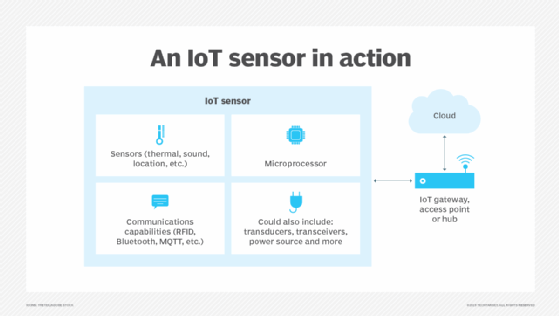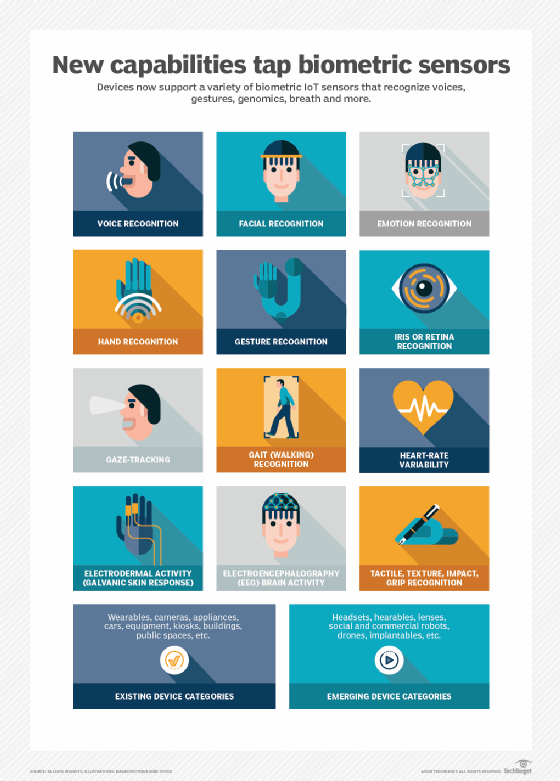sensor data
What is sensor data?
Sensor data is the output of a device that detects and responds to some type of input from the physical environment. The output may be used to provide information to an end user or as input to another system or to guide a process. Sensors can be used to detect just about any physical element.
Sensor data is an integral component of internet of things (IoT) and edge computing environments and initiatives. In IoT, almost any entity imaginable can be outfitted with a unique identifier and the capacity to transfer data over a network. Much of the data transmitted is sensor data.
The huge volume of data produced and transmitted from sensing devices provides a lot of information that is often critical to enterprise decision-making. It is a big data challenge that businesses are addressing with sensor data analytics.
How does sensor data work?
Sensors gather and generate information based on the physical conditions surrounding them. Sensors usually include the following:
- a processor to convert physical signals into digital data;
- communications capabilities to transmit data to people or machines; and
- a power source.

IoT is a large wireless sensor network containing an array of IoT devices with sensors attached. Wireless sensor systems combine specialized transducers with a communications infrastructure to monitor and record conditions at various locations. The IoT devices communicate with each other without human intervention.
IoT sensor data exists in three stages on the network that involve elements of data management:
- Creation. The sensor collects signals and turns them into data.
- Transmission. Data generated is sent to other machines using network protocols, such as MQ Telemetry Transport, Hypertext Transfer Protocol and Constrained Application Protocol. Transmission methods vary based on loss-tolerance, security and timeliness requirements.
- Storage. Data is stored in various formats and accessed for use, data analysis and forecasting. In some cases, it is sent in real time immediately after creation. In others, it is stored for a period of time before being sent to its next destination in batches. Storage and bandwidth limitations can dictate the amount of data transmitted and the way it's sent. Cloud-based storage is used for high-volume sensor data.
Types of sensors
Sensors are usually named after the physical parameter they measure. The following is a list of sensor types and how they work:
- Temperature sensors include thermocouples that indicate temperature measuring a change in voltage; infrared sensors that detect emitted infrared energy and infer temperature based on intensity; and semiconductors that detect temperature based on the conductivity of a semiconductor.
- Proximity sensors detect either the presence or absence of a nearby object or material. Inductive proximity sensors sense the presence of a metallic object using an electromagnetic field. Photoelectric ones use a beam of light to detect objects. Ultrasonic sensors use sound to detect the presence of objects.
- Gas sensors, like carbon dioxide sensors, detect the amount of an element in the air. Other examples of gas sensors are air quality sensors, which detect chemicals that indicate air pollution; breathalyzers that detect alcohol in the air; and humidity sensors that measure the air water content.
- Level sensors include point level sensors that measure the level of a liquid or dry material and indicate whether it is above or below what it should be. Continuous level sensors provide a continuous level reading.
- Light sensors, such as light-dependent resistors, measure changes in circuit resistance to determine changes in light intensity.
- Pressure sensors are devices such as a strain gauge, which has a spring element that changes shape as force is applied, affecting resistance and changing the pressure reading. Differential pressure sensors measure the difference between two pressures connected to each side of the sensor.
- Chemical sensors include chlorine residual sensors that measure the amount of chorine in water. PH sensors check the hydrogen-ion activity in a solution to measure its acidity.
- Biomedical sensors encompass medical devices, such as optical heart rate sensors, that use light-sensitive diodes to determine volume changes in the capillaries above someone's wrist. They also include pulse oximeters that shine a light-emitting diode light through the finger of a patient, analyze the character of the light and use that data to determine the amount of oxygen in the blood.

Examples of sensor data
One of the earliest implementations of sensor data was in World War II, where radar was used to detect objects that would not previously have been within the range of sight. The following sensor examples and types of sensor data processing techniques offer insight into the number and diversity of their applications and use cases:
- Accelerometers detect changes in gravitational acceleration in devices, such as smartphones and game controllers, to determine acceleration, tilt and vibration.
- Photosensors detect the presence of visible light, infrared transmission or ultraviolet energy.
- Lidar, a laser-based method of detection, range-finding and mapping, typically uses a low-power, eye-safe pulsing laser in conjunction with a camera.
- Charge-coupled devices store and display the data for an image in such a way that each pixel is converted into an electrical charge. the intensity of the charge in a charge-coupled device is related to a color in the color spectrum.
- Smart grid sensors provide real-time data about grid conditions, detecting outages, faults and load, as well as triggering alarms. They are important to the functioning of smart cities.
- Gyroscope sensors capture the speed and rotation around an axis of an object. For example, gyroscope sensors enable mobile phones to sense the speed they're going and the direction they're facing.
- Infrared sensors measure heat in the surrounding air and detect infrared radiation. They are used in gas warning devices, flame detectors and precision temperature measurement.
Time series data vs. sensor data
The terms time series data and sensor data are similar in meaning. Sensor data can be time series data and vice versa.
The term sensor data emphasizes the data source and the method of data collection. This data comes from sensors.
The term time series data emphasizes the fact that a given data reading or data point represents some aspect of the physical world over a period of time. Time series data is a series of data collected at different points in time and almost always includes a timestamp.
Time series data doesn't always refer to sensor data. For example, stock market data over a period of time is time series data that doesn't come from sensor readings. Time series data can deliver data in batches or in a continuous stream.
Streamed data can be hard to store and manage because of the volume of data created. Often, it requires the use of artificial intelligence (AI) to process. Learn how big data and AI work together to process data and train AI and machine learning algorithms.







